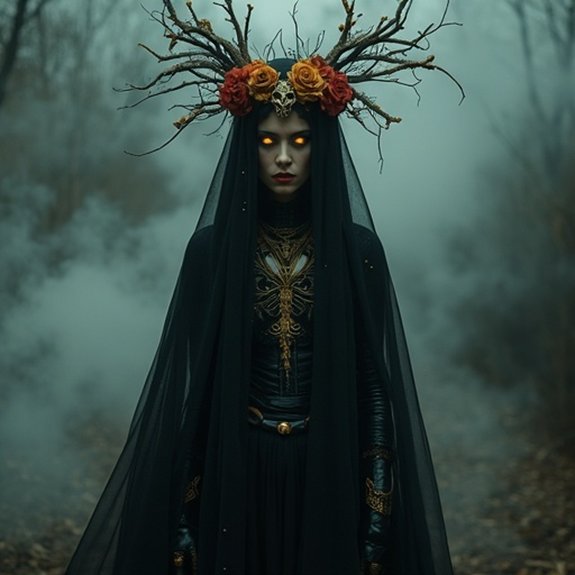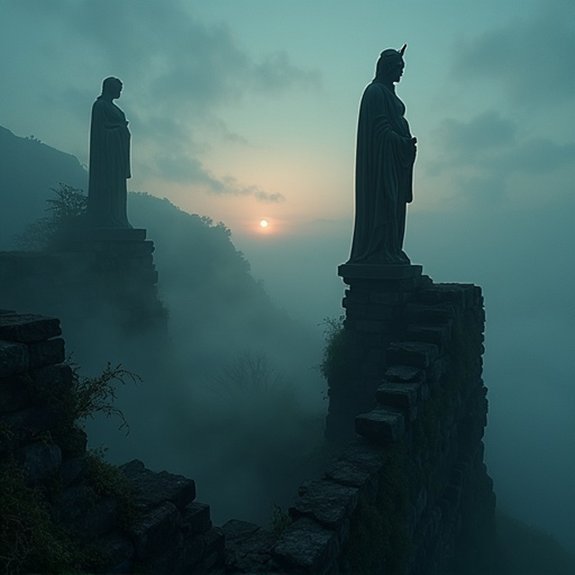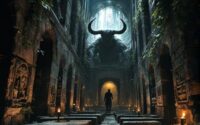The Feminine Divine: Goddesses of Death
Death goddesses have captivated civilizations for millennia, their dual nature reflecting humanity’s deepest fears and most profound mysteries. They’ve served as both destroyers and creators, guiding souls through the afterlife while maintaining cosmic order. From Mesopotamia’s underworld queen to Hindu mythology’s fierce protector, these feminine deities embody transformation itself. Their stories reveal something unexpected about ancient cultures’ understanding of mortality—and the sacred feminine power that governs life’s ultimate threshold.
Introduction

When ancient civilizations sought to understand death’s mysteries, they often personified this ultimate change through powerful female deities. These goddesses didn’t merely represent destruction; they embodied transformation, rebirth, and the natural cycle that governs all existence. From Kali’s fierce dance in Hindu tradition to Hel’s cold embrace in Norse mythology, death goddesses wielded immense power over mortal fate.
Cultures worldwide’ve recognized the feminine connection to life’s beginning and end. Women bring souls into the world through birth, so ancient peoples naturally associated them with guiding souls out. These deities served as psychopomps, judges, and guardians of the afterlife’s threshold. They weren’t evil figures but necessary forces maintaining cosmic balance. Understanding these goddesses reveals how humanity’s ancestors confronted mortality’s reality and found meaning in life’s impermanence.
Ancient Mesopotamian Death Goddess Myths
Ereshkigal ruled the Mesopotamian underworld with absolute authority, making her one of history’s earliest recorded death goddesses. She governed the “Great Below,” where all souls traveled after death, regardless of their earthly status or moral standing. Ancient texts describe her domain as a dark, dusty territory surrounded by seven gates, each requiring the removal of clothing and jewelry from visitors.
The goddess’s most famous myth involves her sister Inanna’s descent into the underworld. When Inanna attempted to conquer Ereshkigal‘s kingdom, she stripped her of power and hung her corpse on a hook. This story established Ereshkigal’s supremacy over death itself. She couldn’t leave her territory but wielded unmatched power within it, judging souls and maintaining cosmic balance between life and death.
Notable Cases or Sightings

While ancient texts don’t record modern sightings of Ereshkigal herself, archaeological discoveries have revealed numerous artifacts depicting encounters with death goddesses across Mesopotamian cultures. The Burney Relief, dating to 1800 BCE, shows a winged goddess flanked by owls—scholars debate whether it’s Ereshkigal or her sister Inanna. Cuneiform tablets from Nippur describe priests’ ritual visions of the underworld queen during death ceremonies.
In 1926, Leonard Woolley’s excavation of Ur uncovered Queen Puabi’s tomb, containing amulets invoking Ereshkigal’s protection. Clay figurines from Tell Asmar depict worshippers offering gifts to a seated death goddess. Most significantly, the Epic of Gilgamesh preserves Enkidu’s vivid dream encounter with Ereshkigal’s domain, describing her as having a lion’s head and eagle’s talons—an account that’s influenced death goddess imagery for millennia.
Common Theories or Explanations
Although scholars have proposed numerous interpretations of death goddess mythology, three primary theories dominate academic discourse about figures like Ereshkigal. The psychological interpretation suggests these deities represent humanity’s attempt to personify and understand mortality through feminine archetypes associated with birth and transformation. Carl Jung’s followers argue they’re manifestations of the collective unconscious, embodying the “terrible mother” archetype.
The sociological theory posits that death goddesses emerged in agricultural societies where women controlled funeral rites and ancestor worship. This explanation links their prominence to matriarchal religious structures predating patriarchal pantheons.
The ecological interpretation views these goddesses as symbols of natural cycles—decay, renewal, and seasonal change. Scholars note that many death goddesses also govern fertility, suggesting ancient peoples understood death’s role in sustaining life.
Frequently Asked Questions
How Do Modern Pagans Worship or Honor Death Goddesses Today?
Modern pagans honor death goddesses through altar offerings, ancestor veneration rituals, and seasonal celebrations like Samhain. They’ll meditate on mortality, perform divination, create devotional art, and conduct cemetery visits while seeking wisdom about life’s cycles.
What Offerings Were Traditionally Given to Appease Death Goddesses?
Ancient peoples offered death goddesses blood sacrifices, food, flowers, incense, and precious objects. They’d leave honey, wine, grain, and sometimes animals at shrines. Personal items from the deceased often accompanied prayers for safe passage.
Are There Any Death Goddesses in Indigenous American Mythologies?
Yes, Indigenous American mythologies feature several death goddesses. The Aztec’s Mictlancihuatl rules the underworld alongside her husband. The Maya’s Ixtab governs suicide victims’ afterlife. Various tribes honor female spirits who guide souls through death’s passage.
What Symbols or Animals Are Most Commonly Associated With Death Goddesses?
Death goddesses commonly associate with owls, ravens, and serpents as their sacred animals. They’re often depicted with skulls, bones, veils, and torches. Black dogs, spiders, and moths also appear frequently in their iconography across cultures.
How Do Death Goddesses Differ From Male Death Deities Culturally?
Death goddesses often embody nurturing aspects of death—rebirth, transformation, and maternal guidance through the afterlife. Male death deities typically represent judgment, punishment, or warfare. Goddesses emphasize death’s cyclical nature while gods stress finality and authority.


